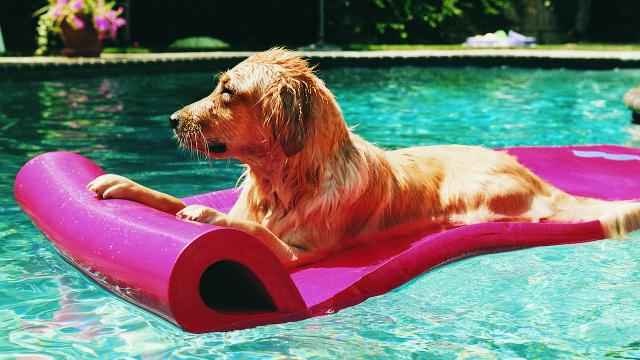Hot weather can be dangerous to our canine friends. Humans can sweat all over our body, but dogs can only sweat on their paw pads, which is not much use when it comes to shedding body heat.
So how hot is too hot to take your dog out? It depends on the dog and their individual risk factors (more on that in a minute). For me, 33℃ is where I start to consider whether or not to take my dogs outside, and try to think of cooler places we could visit.
If they were older or heavier, I might not take them out at all on days over 30℃. Dogs can struggle on very humid days so I factor that in, too.
Here’s what you need to know about how to care for your dog on a hot day.
What are the risk factors?
A dog’s main cooling mechanism is panting, which draws air through the nasal cavity and the mouth and over the capillaries found there.
This allows for evaporative cooling, just as sweat on our skin does, but it happens inside rather than outside. It’s also a much smaller surface area than our skin, so dogs are generally not as good at shedding body heat as humans.
If the dog is overweight, they may have more trouble keeping cool than if they are lean.
A dog with underlying health issues such as heart problems may also be at greater risk.
Very young or old dogs may have more trouble with temperature regulation.
Dogs that have had a chance to get used to warmer temperatures over a month or so are less susceptible to heat distress.
Because some cooling occurs in the nasal cavities, dogs with short faces have fewer of these cooling structures and are more susceptible to heat distress.
Dogs with long noses have more surface area for cooling in their nasal cavities, and are theoretically more resistant to heat distress as a result. But much depends on the individual dog and its history.
Your dog’s coat plays a role but should we shave them?
Larger or heavier-bodied dogs generally shed heat more slowly than smaller dogs, as is the case across the animal kingdom. For example, smaller penguin species tend to visit warmer climates, while larger penguin species stay in colder climates.
Dogs from cooler climes tend to have heavy, insulating coats while those from warmer places tend to have thin hair, which helps shed heat quickly.
So, would your dog be cooler if you shaved them for summer?
It’s true insulation works both ways; cold or hot air outside the body cannot easily penetrate a thick coat and affect core temperature. But a dog is always producing body heat, especially when they are active or excited, and this internal heat may escape slowly through a thick coat.
For many thick-coated, otherwise healthy dogs, it helps to keep their coat free of tangles and dead undercoat during warmer months. This reduces the insulating properties of the coat.
Clipping the coat shorter can allow them to stay cool more easily. You could also consider clipping the belly and groin very short. This won’t help much when the dog is active but could help when the dog lies on a cool surface. However, be mindful not to go too short on upper parts of the coat, or the skin can be exposed to sunburn.
How to ‘ask your dog’ how they’re doing
We should always “ask the dog” how they are doing.
Signs a dog is too hot include:
- panting a lot during the warmer months, even when not exercising
- seeming lethargic and reluctant to exercise
- regularly seeking to cool themselves by getting wet, or lying on cool tile or wood floors with as much skin contact as possible.
Always consider the following rules of thumb:
- if it’s too hot for you, it’s probably too hot for your dog
- make sure water is available for drinking or immersing the body in when exercising on hot days
- know your dog’s panting. Dogs usually have a pant cycle where they pant for a short period and then stop for a few breaths or more and then start again. If they start panting constantly, they may be struggling to cool themselves
- if they can’t hold a ball or toy anymore, froth at the mouth because they can’t easily swallow, or have trouble drinking due to panting at the same time, get your dog to some shade and let them rest. Monitor for signs of heat stress
- signs of extreme heat distress include: vomiting, diarrhoea, lethargy, being unsteady on their feet, or limping. Take your dog to the vet immediately if you see these signs. Heat injury can be lethal!
- pick shady, cool places to let your dog have a run if it’s warm. Go early or late in the day when the temperature has come down a bit. Early mornings are typically cooler than the late afternoon
- the lack of airflow in cars can turn them into deadly ovens within a few minutes, even if the windows are down. So never leave your dog alone in a car, even for a few minutes.

Melissa Starling, Postdoctoral researcher, University of Sydney
This article is republished from The Conversation under a Creative Commons license. Read the original article.

Leave a Reply
You must be logged in to post a comment.